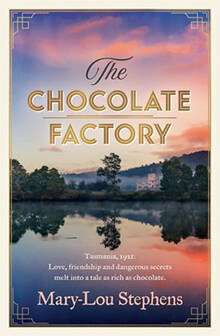 As with Mary-Lou Stephens’ earlier book, The Last of the Apple Blossoms, my approach to The Chocolate Factory was a bit different.
As with Mary-Lou Stephens’ earlier book, The Last of the Apple Blossoms, my approach to The Chocolate Factory was a bit different.
The previous novel began at the time of the February 1967 bush fires in southern Tasmania, something my family lived through and of which I have strong memories. Between Hobart suburbs and the Huon Valley, the geography was also super familiar to me.
Much of The Chocolate Factory is set in and around the Cadbury’s factory at Claremont. This is also well known territory and very personal to me. Both my parents worked for over 10 years at Cadbury’s and we lived on the western fringe of Claremont at the foot of Mount Fawkner (maps say Faulkner but our school house was Fawkner after the settler, so we called the mountain the same).
While the events in the book take place in the early 1920s as the factory is being built, the geography of the site was very clear to me, as was the layout of the surrounding estate. I played soccer on fields bordering the cottages referred to in the book.
I remember Claremont railway station well, before it was closed in my final year at Claremont High School, 1974. And that school, opened in 1961 and merged with Rosetta High to become Montrose HS in 2011, stands across the suburb of Windermere from the edge of the river where the peninsula hosting the factory begins.
So, even with a time span of 50 years between the book’s setting and when I lived there, The Chocolate Factory’s geography brings back very strong memories for me.
And what of the book itself?
Stephens has developed into a very fine fiction writer. She has the critical knack of getting inside her characters’ heads, and taking readers with her. I like the way Stephens lets her characters jump to conclusions that turn out to be wrong, taking the reader along for the ride.
She also is very adept at describing the visual appearance of people and locations, making it easy to picture the characters and events vividly in your mind’s eye.
The story is very engaging, with intertwined sequences of events that both drive the narrative and create character studies. There are mysteries to be unravelled and puzzles to be solved, with some great plotting leading to plenty of unexpected twists towards the end.
There’s plenty of romance – often thwarted, restrained, misunderstood, or apparently unrequited, which means passions are more internalised than acted on, until the narrative lets true feelings come out.
And there’s a vivid historical aspect to the book, putting the story of Cadbury’s itself into context as an international commercial venture and giving a strong sense of the times in post-World War I Hobart and by extension Australia.
That’s a lot to pack into 448 pages, but Stephens makes it an easy and engaging read, well-paced as a story and well-balanced between characters and events, supported by a structure of chapters that in turn focus on the two main female characters.
For me, of course, there was the extra bite of nostalgia for the place I grew up. The Chocolate Factory evoked memories I hadn’t thought about it in years.
When I was 10 or 11, I’d visit a friend early on Sundays and we’d go down to the river to fish off the jetty at Austins Ferry as the Bridgewater Jerry came rolling down the Derwent. I hadn’t thought about that peculiar thick fog in decades, and it’s only a minor observation in the book, but it made my heart leap.
The question is, what, when and where in my childhood and youth will Stephens set her next novel? Youth hostelling along the east coast of Tasmania? Fruit picking in Sandfly with African revolutionaries? Stumbling on the hydro-electric ghost town of Waddamana? I can hardly wait!
In the meantime, The Chocolate Factory is highly recommended.